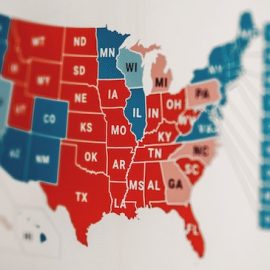

This article is an excerpt from the Shortform book guide to "The Light We Carry" by Michelle Obama. Shortform has the world's best summaries and analyses of books you should be reading.
Like this article? Sign up for a free trial here.
How does fear stop you from achieving your goals? What can you do to stop your fears from controlling your life?
Fear is the main factor that prevents people from going after their dreams and reaching their full potential. When you face and conquer your fears, you’ll grow more confident in yourself and in your ability to handle any curveballs life throws at you.
Here’s how fear prevents you from living life to the fullest and some tips for conquering your fears once and for all.
Overcoming Fear
Fear is one of the biggest obstacles to nurturing and sharing your unique personhood with the world. Fear stops people from taking action or living up to their potential for positive change. This is because fear is a reaction to the potential of loss, and people don’t want to lose what they already have by striving for something better.
Michelle Obama experienced this fear when her husband Barack Obama told her he wanted to run for president. Her husband believed he’d be a wonderful president, but she didn’t want to lose the stable life they’d built in Chicago or risk the entire country disrespecting them. If she hadn’t overcome this fear, it could’ve prevented the Obamas from nurturing and sharing their personhoods and creating change on a national scale.
(Shortform note: In The War of Art, Steven Pressfield agrees that fear, particularly the fear of loss, is an obstacle to nurturing personhood. However, Pressfield adds another source of fear: success. We fear success because once we’ve succeeded, we’re expected to maintain that success, and we’re afraid of that pressure. This fear can stop us from nurturing our personhood since doing so helps us live up to our potential—a form of success. Fear of success might have contributed to Obama’s fear about her husband running for president: She was afraid of being judged, and people would’ve likely judged them more harshly if they succeeded initially only to fail later.)
Work through fear instead of succumbing to it, Obama advises. When you overcome your fears, you increase your competence—your ability to handle difficult situations. This helps you approach the future confidently, knowing you can handle whatever situations might arise. This was the case for Obama, who says she’s more confident in herself and her ability to handle whatever life throws at her after overcoming her fear and agreeing to her husband’s presidential campaign.
| Conquering Your Fears Through Confidence Obama says that you can increase your confidence that you can handle difficult situations by facing your fears. Some experts believe that having this confidence is not just a result of facing your fears but is also important to doing so in the first place. Confidence that you can handle difficult situations makes it easier to face your fears, since you know you’ll manage if your fear comes true. Thus, while overcoming her fear of her husband running for president, Obama likely had more confidence in her ability to adapt and withstand judgment than she initially felt. Build this confidence by considering what would happen if your fear came true and how you’d handle it. For instance, if Linda’s afraid of crashing her car, she could think about how she’d handle the repairs and injuries that might result from a crash. Knowing she could handle the situation, even if it would be unpleasant, increases her confidence and helps her overcome her fear. |
Here, we’ve organized Michelle Obama’s strategies for working through fear into three steps:
Step #1: Accept Fear
The first step of working through fear is accepting that fear is an inescapable part of life. Fear is impossible to avoid because every person can lose something, whether it’s money, a friend, or even their life. It’s impossible to eradicate fear, and trying to do so will cause frustration and make it difficult to nurture your personhood.
(Shortform note: Experts agree that it’s harmful to try to eradicate your fear, adding that fear grows stronger when it’s ignored. Fear is a notification: It tells you there’s an issue you must address. When you ignore this notification, those issues can worsen. For example, if you suppress fear about a relationship, you won’t fix the problems that are harming the relationship and causing your fear, and the relationship might crumble further. Also, suppressing fear uses a lot of energy and can cause physical issues like high blood pressure. Eventually, you’ll be too tired to suppress the fear and it’ll overwhelm you.)
Step #2: Define Fear
The second step of working through fear is defining your fears. This helps you identify which fears are stopping you from taking on new challenges that nurture your personhood. According to Obama, there are two types of fear:
1. Protective fear—which Obama calls rational fear—shields you from real threats. This kind of fear is necessary and helpful. For example, the fear of getting hit by a car keeps us from walking in the street. You should listen to this kind of fear to avoid dangerous situations.
2. Restrictive fear—which Obama calls irrational fear—prevents you from growing and having new, positive experiences. Rather than being helpful, this kind of fear magnifies minor threats until you’re paralyzed. For example, a fear of rejection stops you from having meaningful relationships. You must overcome this kind of fear.
(Shortform note: Psychologists agree that protective fears should be listened to and restrictive fears should be faced. However, they add that whether a fear is protective or restrictive can change depending on the context, as certain threats become more or less likely. For example, the fear of a bear attack while camping is rational because you’re in a location where bears live. That same fear is irrational in a city because the odds of a bear being in the city are low. This implies that you may have to redefine your fears several times as your circumstances change.)
How to Define Fear
To define fear, Obama says to explore the object of your fear to understand how dangerous it actually is. The better you understand your fears, the better you’ll be able to recognize when those fears are stopping you from nurturing your personhood. You’ll understand whether your fear is protective or restrictive, which makes it less powerful.
For example, if Kelly has a phobia of thunder, she believes thunder is a threat. As a result, she might refuse to leave the house during storms. This can greatly limit her activities and make her feel isolated. By learning about thunder, Kelly can realize it’s only noise and can’t hurt her. She can identify her fear as restrictive and feel less afraid.
| Reflect on Your Fear To explore your fear successfully, focus on taking deep, even breaths when you feel afraid instead of focusing on the fear. The goal isn’t to alleviate or dismiss the fear, but to shift your attention away from it enough that you can think clearly. Once in this calmer state, think about where the fear came from, when you first felt it, and what information it’s trying to convey. As Obama says, this can make your fear less powerful. This is because knowing more about your fear means you can plan how to protect yourself, making you feel more secure and less afraid. This applies whether the threat is real or not—Kelly felt less afraid after realizing she wasn’t actually in danger, but someone who is in danger can also feel less afraid after making a plan to protect themselves. |
Step #3: Face Restrictive Fears
The final step of working through fear is facing your restrictive fears. Obama explains that defining a fear as restrictive makes it less powerful but doesn’t help you overcome the fear entirely. To do that, you must nurture your personhood by facing your fears. In our example, knowing that thunder is only noise reduces Kelly’s fear, but unless she can leave the house during a storm, the fear still controls her. To overcome her fear, Kelly must go outside when it’s thundering—and going outside will arguably allow her to connect with others, thus nurturing and sharing her personhood.
(Shortform note: Psychologists agree that people need to face the objects of their fears to overcome them. This is because a big part of overcoming fear is rewiring your neural pathways, teaching yourself that your fear isn’t likely to come true. To do that, you need to experience that fear not coming true: Your brain needs concrete information from personal experience to rewire your pathways, they imply. Thus, if Kelly never goes outside when it’s thundering, she doesn’t give her brain concrete evidence that it’s safe to do so, and she won’t overcome her fear.)

———End of Preview———
Like what you just read? Read the rest of the world's best book summary and analysis of Michelle Obama's "The Light We Carry" at Shortform.
Here's what you'll find in our full The Light We Carry summary:
- Michelle Obama's advice on fulfilling your potential in life
- The benefits of nurturing and sharing your unique abilities and strengths
- How to overcome the obstacles to reaching your potential and creating change






